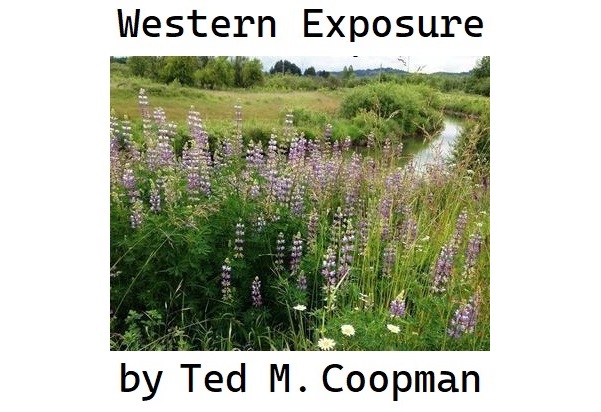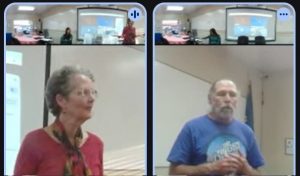All we are saying, is give trees a chance
6 min read
by Ted M. Coopman
Trees are pretty, absorb carbon, reduce ground temperatures, slow traffic, make people happier, foster wildlife, and are cheap to maintain. So why are we hell-bent on removing them?
Despite the eco-groovy rhetoric, Eugene has no meaningful tree protection. If you want to cut down a tree, regardless of size, you can generally do it, though you may have to pay a nominal fee.
If the city wants to remove trees for transit or any other reason, it is actually easier for the city to do it than a private property owner. Road work, housing, utilities—everything comes before trees. Move a street or sidewalk? Redesign a building? The city typically says: “Hell no, just cut down the tree.”
Now Gov. Kotek is suggesting that cities reduce tree protection to encourage more housing.
This is all lazy zero-sum thinking. Instead of butchering trees, we should work around this amazing natural infrastructure. Working with trees instead of chopping them down for our own convenience (and to make a few bucks) is where we should start.
Simply planting new trees is not a viable alternative to replace mature trees. It takes decades for a tree to start to pull its weight for absorbing carbon and other pollutants, processing rainwater, and creating cooling shade and wildlife habitat. In the meantime, that is tons of carbon and pollution not getting absorbed.
Urban deforestation is a major problem in U.S cities. A study in the May 2018 issue of Urban Forestry and Urban Greening reports that nationwide, metropolitan areas are experiencing a net loss of about 36 million trees every year or about 175,000 acres of tree cover. Most of the loss is in central city and suburban areas, but it is also occurring on the exurban fringes, resulting in an annual loss of about $96 million (about $112 million in 2023 dollars) in benefits.
Allowing for increased lot coverage reduces the space needed for trees and often comes at the expense of removing mature trees. Typically, you can gauge the socioeconomics of a neighborhood by the density of trees. In most cases, increased density, either via larger homes or multiplexes, happens in lower income neighborhoods since land is cheaper. So much for equity.
Urban forestry expanded aggressively at the turn of the 20th century. You can see the results in the massive big leaf maples and even redwoods in my Jefferson Westside neighborhood. Unfortunately, they were not really thinking about the kinds of trees that should be planted near infrastructure, so you have a lot of torn up sidewalks too.
Several years ago, Lane Transit District wanted to run an EmX line down West 11th. That would have involved the removal of most of the street trees between Lawrence and Chambers – take that drive and think about how that would look.
The neighborhood successfully fought that off and is still widely criticized for being “anti-transit.” But consider that producing one ton of cement, the principal ingredient in concrete, emits on average between 0.8 and 1.0 tons of CO2. The amount of carbon “saved” via buses would not come close to the carbon-intensive concrete required for the EmX line, let alone all the carbon those mature trees would have sucked out of the atmosphere.
Advocates were so focused on “bus good” they could not, well, see the forest for trees as far as reaching the underlying goals.
But here is the deal: A mature tree does some serious heavy lifting in almost every aspect of life, health, and public safety. Consider:
Trees help mitigate global warming and save energy. Trees sequester carbon. An average mature oak will sequester about 48 pounds of carbon per year and absorb other pollutants, including ozone, xylene, and benzene. Leaves absorb light energy, thereby reducing reflected heat. They also absorb water through their root system and release moisture through the leaf surfaces via transpiration, which cools the air. Shading impervious surfaces such as driveways, sidewalks, streets, and parking lots improves microclimates significantly by reducing glare and reflected heat.
Trees help mitigate extreme weather impacts. On average, a single mature, leafy tree can absorb hundreds of gallons of water through its roots every day, as well as capturing rainwater on the surface of its leaves. Their roots also reduce soil erosion in the ground and slow the filtration of water into our city’s drainage networks. This is particularly important in neighborhoods where a large proportion of the ground’s surface is made up of impermeable materials, like tarmac and concrete. Trees can reduce the surrounding air temperature, as well as the temperature directly under the tree. Trees can also significantly reduce wind speed up to a distance 10 to 20 times their height.
Trees reduce pollution and make us healthy. Trees are important for a healthy ecosystem by cleaning our air, water, and soil and absorbing storm water that normally would end up in our rivers. Trees absorb other airborne pollutants (such as ozone) and they even have the ability to clean contaminated soil and ground water. Street trees absorb nine times more pollutants than more distant trees. Exposure to greenspaces can be psychologically and physiologically restorative by promoting mental health, reducing blood pressure and stress levels, and by promoting physical activity.
Trees make streets safer. Inclusion of trees and other streetscape features in the roadside environment may actually reduce crashes and injuries on urban roadways. Urban street trees create vertical walls framing streets, providing a defined edge, helping motorists guide their movement and assess their speed, leading to overall speed reductions. Motorists perceive it takes less time to transit treed versus non-treed environments, which can reduce speeding.
Trees make us saner. Having access to views of natural settings have been found to reduce crime and aggression and improve recovery from surgery. Tree-filled neighborhoods lower levels of domestic violence and are safer and more sociable.
Trees provide habitat. Trees provide habitat for insects, birds, bats, and other urban wildlife. Large, old trees feed and shelter birds and small mammal species. Many animals also use mature trees for reproduction sites, nesting, resting and for places from which to hunt or capture prey. By welcoming birds, bats, and other insectivores, humans and trees alike benefit from the resulting insect pest control. Birds use the branches of mature trees for nests. Additionally, plants, lichens, and fungi may use a tree as a growing substrate or food source.
Trees save or even make us money. In the winter, trees protect homes from wind and reduce heating costs. The overall cooling effect of the average single, mature tree is equivalent to several air conditioning units. Trees can increase the property value of a home. Businesses on treescaped streets show measurably higher income streams. The shade of urban street trees can add more life to costly asphalt.
For all these reasons, there are few improvements that offer as many benefits as mature street and yard trees. If we are serious about equity, meeting our climate targets, and Vision Zero, tree preservation and canopy expansion should take priority over other types of development.
The benefit of protecting and preserving this arboreal system far outweigh any advantages gained by discretionary tree removal.
All I am saying, is give trees a chance…
Learn more about trees at www.friendsoftrees.org, 541-632-3683, and check out the Friends of Trees / Jefferson Westside tree proclamation from Fall 2019.
Western Exposure is a semi-regular column that looks at issues and challenges from a West Eugene perspective – a perspective that is often ignored or trivialized by city leadership and influential groups and individuals largely based in south and east Eugene.
Western Exposure rejects the fauxgressive party line, performative politics, and “unicorn ranching” policy in favor of pragmatism focused on the daily experiences of residents and small businesses in Eugene—and West Eugene in particular.
Ted M. Coopman has been involved in neighborhood issues since 2016 as an elected board member, and now chair, of Jefferson Westside Neighbors and has 30+ years experience as an activist and community organizer. He earned a Ph.D. in Communication (University of Washington) and served on the faculty at San Jose State University from 2007 to 2020.
Ted’s research on social movements, activist use of technology, media law and policy, and online pedagogy has been published and presented internationally and he taught classes ranging from research methodology to global media systems. He and his spouse live in Jefferson Westside with an energetic coltriever and some very demanding and prolific fruit trees.



